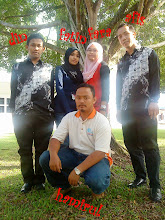1. The equivalent of a glass of water (that is, 270 g of liquid) at 20.0 °C receives 1000 cal from a candle flame. Assuming that all the energy goes into the water without any losses, what is the final temperature of the liquid?
SOLUTION
Q = 1000 cal = cm( - )
Q = (1.00 cal/g∙C˚)(270 g)( - 20.0 )
and
= (1000) /((1.00 cal/g∙C˚)(270 g)) +20.0˚C = 23.7
2. A cooper pot has a mass of 0.50 kg and is at 100. How much heat must be removed from it if its temperature is to be lowered to precisely 0?
SOLUTION
Given : cu, m = 0.50 kg,
= 100
= 0
∆T = -100 K
Q = m∆T
= (390 J/kg∙K)(0.50 kg)(-100 K)
= -19.5kJ / -20kJ
3. A ontainer holding 0.250 kg of water at 20.0 is placed in the freezer compartment of refrigerator. How much energy must be removed from the water to turn it into ice at 0 ?
SOLUTION
Given : water, = 0.250 kg
= 20.0
=0
Q = ( - ) + (-)
Q = (4.186 kJ / kg∙K)(0.250 kg)(0 - 20.0 - (0.25kg)(334 kJ / kg)
= -20.9 kJ – 83.5kJ
= -1.04 105 J
4. How much heat must be added to a 1.0 kg mass to of water ice at -10 ˚C and atmospheric pressure, in order to transform into superheated steam at 110 ˚C?
SOLUTION
Given : m = 1.0 kg
= -10 ˚C
= 110 ˚C
Q = ∆ + + ∆ + + ∆
Q = (1.0 kg)(2.1 kJ/kg∙K)[0 ˚C –(-10˚C)] + (1.0 kg)(334 kJ/kg)
+(1.0 kg)(4.2 kJ/kg∙K)[100˚C-(0˚C)] + (1.0 kg)(2.26 103 kJ/kg)
+(1.0 kg)(2.0 kJ/kg∙K)[110˚C-100˚C
Q = 21 kJ + 334kJ + 420kJ + 2260 kJ + 20kJ
= 3055kJ
5. A slab having thickness of 4cm and measuring 25cm on the side has a 40 ͦ C temperature difference between its faces. How much heat flows through it per hour? the conductivity k is 0.0025 cal/s . cm . ͦ C.
Q =[k (area)(th – tc)(time)] / thickness = 0.0025(25 x 25)(40)(3600 / 4
= 56.25 kcal.
6. A refrigerator door is 150cm high, 80cm wide, and 6cm thick. If the coefficient of conductivity is 0.0005 cal/cm . s . ͦ C, and the inner and outer surfaces are at 0 and 30 ͦ C, respectively, what is the heat loss per minute through the door, in calories?
Q = kA(th – tc)(time) / d = 0.0005(150 x 80)(30 ͦ C - 0 ͦ C)(60) / 6
= 1800cal.
7. how much water at 100 ͦ C could be evaporated per hour by the heat transmitted through a 1cm x 1cm steel plate 0.2cm thick, if the temperature difference between the plate faces is 100 ͦ C? For steel, k is 0.11cal/s . cm . ͦ C.
Q = (0.11cal/s . cm . ͦ C)(1cm2)(100 ͦ C)(3600s)
0.2 cm
= 198 kcal.
8. What thickness of wood has same insulating ability as 8cm of brick?
k = 0.8W/m . K for brick and 0.1W/m .K for wood.
:: for the same ∆T and A, the ∆Q / ∆t is the same in two materials, so
Kw / Lw = kb /Lb, and the wood thickness is Lw = (0.1/0.8)(8cm)
= 1cm.
9. Distinguish between natural and forced convection.
• If the motion of a fluid is caused by a difference in density that accompanies a change in temperature, the current produced is referred to as natural convection. When a fluid is caused to move by the action of a pump or fan, the current produced is referred to as forced convection. Both type of convection are employed in a common home heating system : hot water is circulated through “radiators” by forced convection; the warmed air rise by natural convection.
10. Forced air flows over a convection heat exchanger in a room heater, resulting in a convective heat-transfer coefficient h = 200Btu/h . ft^2 . ͦF. the surface temperature of the heat exchanger may be considered constant at 150 ͦF, and the air is at 65 ͦF. determine the heat exchanger surface area required for
30 000Btu/h of heating.
H= hA∆T. from the information given,
(30 000Btu/h) = (200Btu/h . ft^2 . ͦF)A A = 1.765 ft^2.
Subscribe to:
Post Comments (Atom)

No comments:
Post a Comment